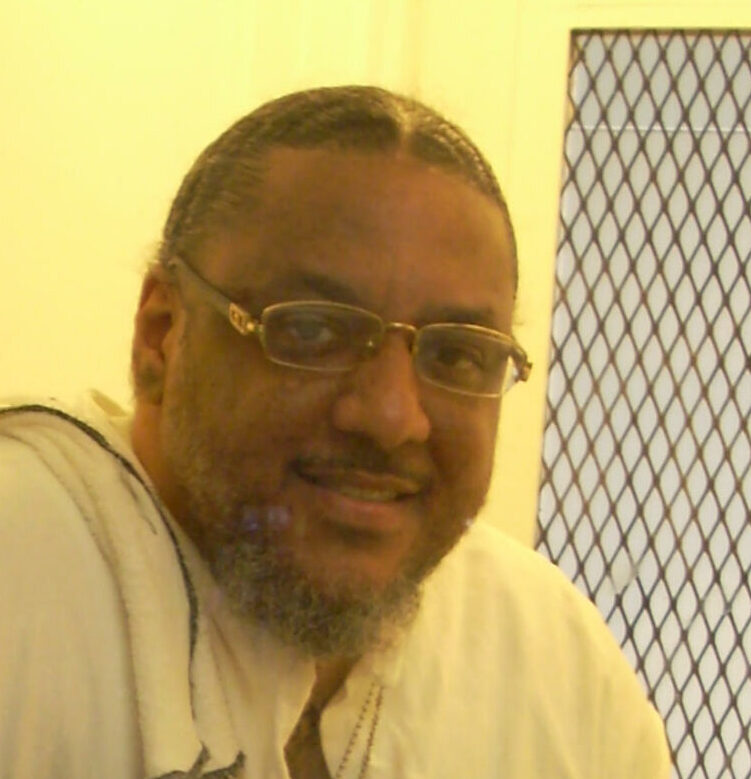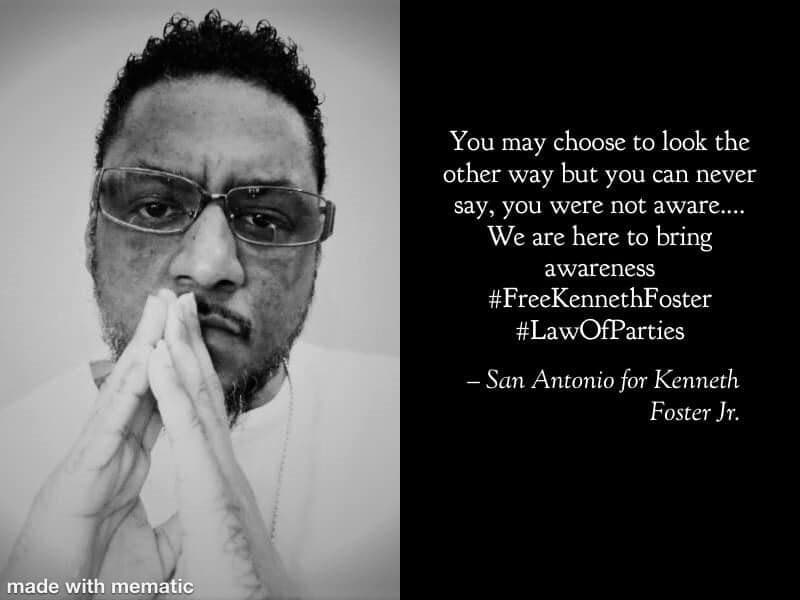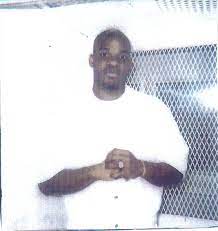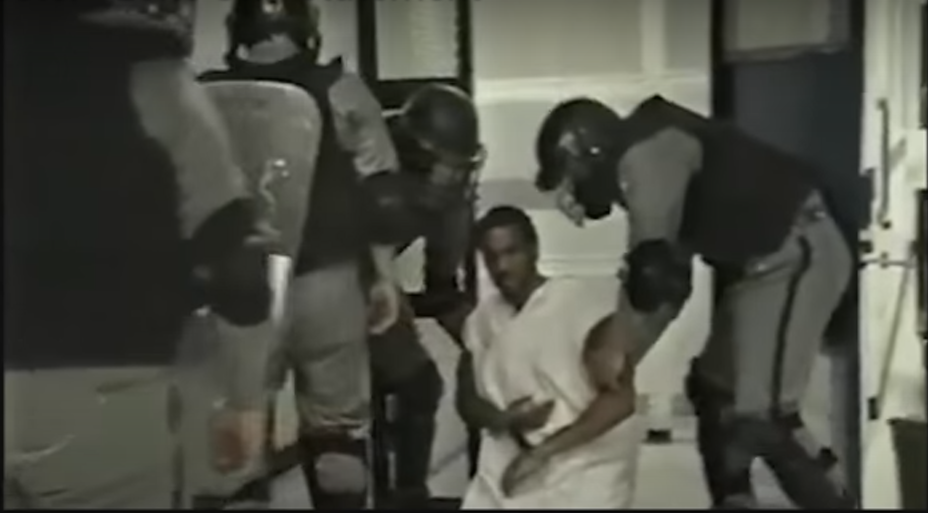by: Kenneth E. Foster Jr.
The death penalty is, and as long as it exist will most likely remain, a highly debated topic. Due to the extreme variations between political and religious views the death penalty has drawn some sensitive lines among cultures, countries and even families. Will fairness, justice and peace ever come from this issue? Insights of this country’s history with racial injustices and struggles on civil rights, most likely not!
When all of the propaganda from pro-death penalty advocates are pushed to the side the death penalty boils down to 2 things:
1) a political tool used to instill fear into society with the faux-ideology that it deters crime
2) a systematic scheme used as a means of genocide on certain groups of people within this society.
If the facts are honestly accepted these 2 points will be confirmed moreso than the pseudo-ideology of the death penalty being a deterrent to crime and a process that helps rid society of it’s most heinous criminals, ones who cannot be rehabilitated.
The death penalty is controlled by political interest and social prejudices. Most capital cases are tried on how much money a county has to spend, that year, on Criminal Justice issues than the crime itself. A study, revealed by Amnesty International, showed that in Florida, each execution cost the state $3.2 million (six times more than incarcerating a prisoner for life). Texas, with the highest execution rate (over 315 since the reinstatement of the death penalty) spends an estimated $2.3 million per capital case (roughly 3 times the cost of keeping someone in prison for 40 years). *1
When county issues call (eg – educational, medical, street and building constructions, ect.) less money can be spent on capital murder prosecutions. Therefore, many capital murder prosecutions have nothing to do with what is moral or just, but what is economically possible. However, during elections years, when tough on crime slogans come out, you can bet on a rise in capital murder trials.
In addition, statistics, revealed by John Blume, director of the Cornell University Law School Death Penalty Project, showed that chances of a black person being sentenced to death for killing a white is greater that for a white person who kills another white or black. In Virginia, the chances were 18 times greater. The studies suggest that prosecutors tend to seek the death penalty more on blacks because they believe they can win it, specifically because “black life is valued less highly than white life” and “the white-dominated social structure is less threatened by black-victim homicide.” *2
People often frown when thinking a “race card” is being played, yet who can deny the history of America’s south? This point is relevant, as the Virginia statistic, because the south leads the country in executions. Over 80 % of executions have taken place in the south. Half of the U.S death row population is in states of the former Confederacy and 5 out of every 6 person executed in the U.S have been put to death in the south. In Texas, black people make up 12% of the population, but 42% of Texas´ death row. There is no just or righteous consistent method as to how the death penalty is issued or applied. It’s an arbitrary and racist process delt from a tainted deck.
No study has ever shown that the death penalty deters crime and one never will because it doesn’t. Even FBI statistics have shown that the murder rate in some states which use the death penalty is twice that of some states which do not use the death penalty. *3
The death penalty process has also shown to be hypocritical and contradiczive to itself where it says it seeks to execute criminals who’ve committed the most heinous of crimes. What is considered heinous? One may think this is a silly question and quite obvious, but it’s a deceptive use of word. Through the law of parties there are people on death row who’ve never killed anyone, but was allowed to be sentenced to death if a jury believed they conspired to carry out a felony (eg- robbery, kidnapping) and a murder occurred, which the law says they are responsible because a defendant encouraged, aided or assisted the crime. The Supreme Court emphasized that the defendant must have been a major participant in the crime and/or acting with reckless endangerment towards human life. However, D.A.`s are manipulating this law stating that the intent alone, the conspiracy, (even if you were 100 miles away) is enough to make you death eligible. So, if a person is two blocks away while his partner carries out a capital murder would you say his role is heinous and just as death worthy as the actual killer? States such as Texas say yes. I know, because I was convicted under similar methods. Jeffery Dahmer, whose crimes were heinous, never got the death penalty; neither did the Green River Killer (who confessed to a mass of murders). Wouldn’t you agree something is wrong with this picture?
In knowledge of this, how can the death penalty be justified righteously? Who can bring forth some moral issues concerning the death penalty? No matter how clean you carry out an execution it’s still a murder. It’s appauling when this system puts on a get though on crimes facade and screams for the death penalty, but, as a statistic showed, by the time a child reaches the age of 20 they’ve seen 40,000 murders on TV. If this country is truly concerned with murders why does if glorify it so much?
Never has the Government put forth a study to analyze what makes a capital murderer commit his/her crime. They’d like to pass it off simply as these people are savages. This is so because the problems will more than likely be social ones than anything else. Jeffery Rieman, who wrote “A Radical perspective on crime” stated: “ Crime is a means by which people who believe in the American dream pursue it when they find the traditional routes barred.” One out of every two black child and two out of every five Hispanic child lives in poverty. America has the resources to where no person has to be hungry or under-educated. If America wanted it could abolish poverty. Without poverty crime would be extremely low, but abolishing poverty would greatly diminish the capitalist infra-structure which this country thrives on. With approximately 3,500 death row inmates, at approximately 1 million dollars per case, just think what that $3,500,000,000 could have done for impoverished neighborhoods, troubled youth and struggling families. But, to avoid the issues an extermination process and smear campaign against the poor and troubled are carried out. So, does capital punishment really address our social problems?
It’s tue that people sentenced to death aren’t housed to be rehabilitated, but does that mean nothing can be learned from the process and situation? Here on Texas´ death row we have been housed in an environment designed to induce punishment administration segregation. This building was purposely constructed to act as a punitive segregation. From the single man recreation yards and dayrooms, stell doors, white walls and brightr cell lights it was made to break the spirit. They’ve succeeded as many inmates suffer from sensory deprivation symptoms and some have committed and attempted suicide. This is a housing unit where, normally, inmates who received a disciplinary infraction would come to carry out a solitary sentence and once they modified their behaviors would be place back into general population. We are housed here permanently. Due to being in single man recreation dayrooms we’re not given recreational games (like chess boards, dominos ect.); due to the administrations oppressive attitudes towards our death row classifications we aren’t given in-cell recreational arts and crafts; and to spite us we aren’t allowed TVs. Next to a radio and our imagination, plus desire to live, grow, learn and love is the only things to sustain us. Texas position is that we’re here to be executed, not cultivated or rehabilitated, thus they plan to keep us in existence by the lowest means possible until those executions are carried out.
In face of these conditions (many mimiced in other states) politicians are dealing with resistance as death row inmates are continually fighting back , not physically, but politically, socially and spiritually, by participating in positive endeavors. In addition, groups are being invented by inmates that are being put back into society, even for victims families. We realize that if we can disprove the stigmas (that we’re the worse of the worse, incapable of being rehabilitated) we can help abolish the death penalty in another way. This is done by not living up to the stereotypes which will show people in society that the death penalty is an empty ideology based on revenge and murder, thus convincing them to not support it.
In 2004 the 117th death row inmate was released. While many people would like to see death row prisoners lined up and shot, and could especially careless to if we are treated humanely, how can these types of housing conditions be allowed when Innocent men are on death row? Each year the number rises, so Innocence on death row can’t be denied. The bigger question is why does society allow the death penalty to exist when symptoms overwhelmingly show a broken and bias system? The true meaning of justice for all has been abandoned and the is no respect for the sanctity of it or life. The death penalty is a deceptive and frivolous magic trick used by politicians to dazzle the public. However, once they execute the prisoners the social problems have not disappeared. There comes a time when the citizens of America just need to face the realities of their problems. Until we eradicate the acceptance of racism and classism our society will continue to suffer from these self-inflicted wounds. Therefore, the penalty of death that was said to be reserved for the worse of the worse criminals has infact been turned directly upon our entire society. Insights of all this we shouldn’t be surprised at our social decay. In the words of Clarence Darrow (American lawyer,1930)- “As long as the world shall last there will be wrong, and if no man objected and no man rebelled, those wrongs would last forever.”
*1- www.amnesty-usa.org
*2 this study was published in the March 2004 edition of the Journal of Empirical Legal Studies
*3- www.amnesty-usa.org






